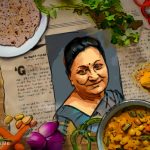Black cookbook authors shift the culinary landscape
The recent addition of cookbooks by black authors to mainstream bookstore shelves reflects the demand for South African food and cooking culture in the country.
Author:
25 March 2020

When South African food icon Dorah Sitole published Cooking from Cape to Cairo: A Taste of Africa in 1999, she was excited to be a pioneer for black chefs in South Africa. She did not expect to be one of the only ones for years to come.
Sitole shared this experience at the inaugural South African People of Colour at the Table Conference in 2019.
Until recently, cookbooks by black South Africans were nowhere to be found in mainstream bookstores. Shelves were (and still are) largely filled with books by white South African authors, featuring recipes that do not represent the food traditions of most South Africans. But now books like Mogau Seshoene’s The Lazy Makoti’s Guide to the Kitchen, Lesego Semenya’s Dijo and Cape, Curry & Koesisters by sisters Fatima Sydow and Gadija Sydow Noordien are remarkably popular and readily available.
Related article:
Although this new generation of black food writers is changing the South African food industry, it was not an easy feat for them to find publishers for their work. At the conference, Seshoene spoke about how publishers told her that “black people don’t buy books”. Her response to them was, “Why would people buy books that don’t represent them?” She announced the seventh reprint of her book in March, more than proving her point.
With the boom in black-authored cookbooks in the past few years, the culinary landscape has started to shift and there is a growing national consciousness and pride in how people relate to their cultural foods. These books have added heart, style and profound meaning to local cookery stands and have challenged the limits of what a cookbook can be. Their success illustrates the hunger people have for books that are relatable and representative.
The Lazy Makoti’s Guide to the Kitchen, Hope Malau’s Johanne 14 and Ishay Govender-Ypma’s Curry: Stories and Recipes Across South Africa are three vital new cookbooks in terms of their cultural impact and deliciousness.
Rooted in tradition
The Lazy Makoti’s Guide to the Kitchen is an elegant cookbook, aimed at the Instagram generation who want to cook delicious, easy and beautiful looking meals. With bright colours and a millennial tone, this book offers a solution to newlywed young women who face the huge pressure of proving themselves in the kitchen to their in-laws, but don’t have the know-how. With sayings like, “by fire, by force”, Seshoene had to convince publishers who hadn’t heard the term not to worry and that the majority of South Africans would get it.
There is a chapter, Khumbul’ekhaya, on traditional meals for “when all you want is Gogo’s cooking”. It contains recipes for sorghum breakfast porridge, umngqusho (samp and beans) and mala mogodu and dombolo (tripe and steamed bread). In her recipe for mopani worms, Seshoene writes, “I know many of you eat prawns but wouldn’t touch a mopani worm, lol,” referring to the two proteins having similar features although one is seen as superior. This hints at the fact that African ingredients are devalued.
Related article:
In her foreword in the book, Sitole writes:
“It has always been my wish that our African food gets the respect and global exposure it deserves. Mogau does this so well in a chapter that she devoted to traditional and township dishes. Our food is amazing! We have to make sure that the younger generations do not forget that.”
The book covers all the basics, from easy meals like cream of chicken soup, the different ways to make eggs, sweets, baked goods, stews and salads to more elaborate dishes like sticky pork belly, curried chicken feet and a unique take on a seven colours lunch.
She also has a chapter that covers African food from the rest of the continent and a genius chapter about repurposing leftovers to make things like butternut fritters and chakalaka shakshuka. The recipes are written with the people of South Africa in mind, using ingredients many will already have in their homes.
A cookbook as a love letter
Malau’s Johanne 14 is made up of extensive recipes compiled as a love letter to his father, Elias Mokoena. The first few pages give a brief glimpse into Mokoena’s life story, with a career in professional bodybuilding and winning competitions like Mr Klerksdorp. He later came to be in charge of the kitchen of a mining hostel, where he honed his cooking skills with the aim of maintaining his physique. In the process, he became loved for his tasty creations.
Malau’s memories of eating warm and comforting meals cooked by his father ignited his own passion for cooking, and his journey began when he visited his father at work and was taken under the chef’s wing.
The name of the book, Johanne 14, comes from the Bible verse John 14:1. “Let not your hearts be weary…” Popular among congregants of the Zion Christian Church, the verse has also come to refer to a versatile vegetable: cabbage.
Related article:
In his cookbook, Malau writes: “Cabbage is a staple township food, second only to maize meal. A head of cabbage can be cooked in so many ways, it’s inexpensive and goes with anything … Hence it’s become known, affectionately, as Johanne 14. If you have cabbage, you should not let your heart be troubled.”
Malau does not romanticise townships. He calls out their sinister creation under apartheid’s Group Areas Act, when there was a mass dislocation of black South Africans to city outskirts, to underserviced areas and a distance away from employment centres. He does, however, describe the cuisine that came out of that struggle as one of resilience and love. Delicious food was made, often from modest means, with creativity and “power to ease a troubled heart”. From this book, it is clear that township cuisine was and is a resistance.
The cultural significance of curry
Govender-Ypma takes a different approach to the classic cookbook format in Curry. It’s a mammoth project with a comprehensive collection of recipes by more than 60 people across the country, which threads together how curry has become a culturally significant food in all the provinces in the country, across all races.
“The Durban curries of my childhood, though a proud and prominent part of South African food culture, are not the defining curries of this land. As I travelled from city to farm, CBD to township, across the breadth of our nine provinces, both the dish and the heart of the people revealed itself to me,” she writes.
The book describes how food traditions have travelled, been maintained and adapted from the time of colonisation, migration, indentured labour and slavery to more recent waves of immigrants. It delves into the contentious history of the word “curry” and its colonial roots as a word inaccurately imposed by the British (with help from the Portuguese) on to specific Indian dishes that are sauce or gravy-based. But the word, and the associated dishes, have taken shape globally and come to represent so many beloved recipes and, as this book shows, a diversity in aromas, flavours, techniques and sentimentalities.
Related article:
While there are some notable chefs included, most of the people are home cooks who were nominated by their communities. All have a curry recipe and a story to share, which Govender-Ypma captures so well, extracting the heart and character of South Africans through a plate of curry.
She reflects that what became clear through the experience of gathering these recipes was that there seemed little opportunity for people to share their stories, and talk about the loss and sorrow of South Africa’s past. She writes that “to dismiss the passing of years since the fall of apartheid as sufficient time to ‘get over it’ does little service to the ordinary South African. Of this, I am now certain.”
Culinary schools in South Africa still teach French recipes and techniques, and European cuisine continues to dominate many restaurants, so there is a way to go before African food becomes as valued at home and internationally. But cookbooks such as these are challenging that notion and getting people to think differently about food. Their increased presence has shown how hungry we are for these recipes, images and stories.
They inspire not only home cooks but also aspiring black food writers, chefs, recipe developers, bloggers, photographers and food stylists. For many who would never have considered a career in food – in all its iterations – seeing beloved traditions and recipes celebrated in print with visually striking images could ignite a new idea or passion, one that many may have thought was not for them.




